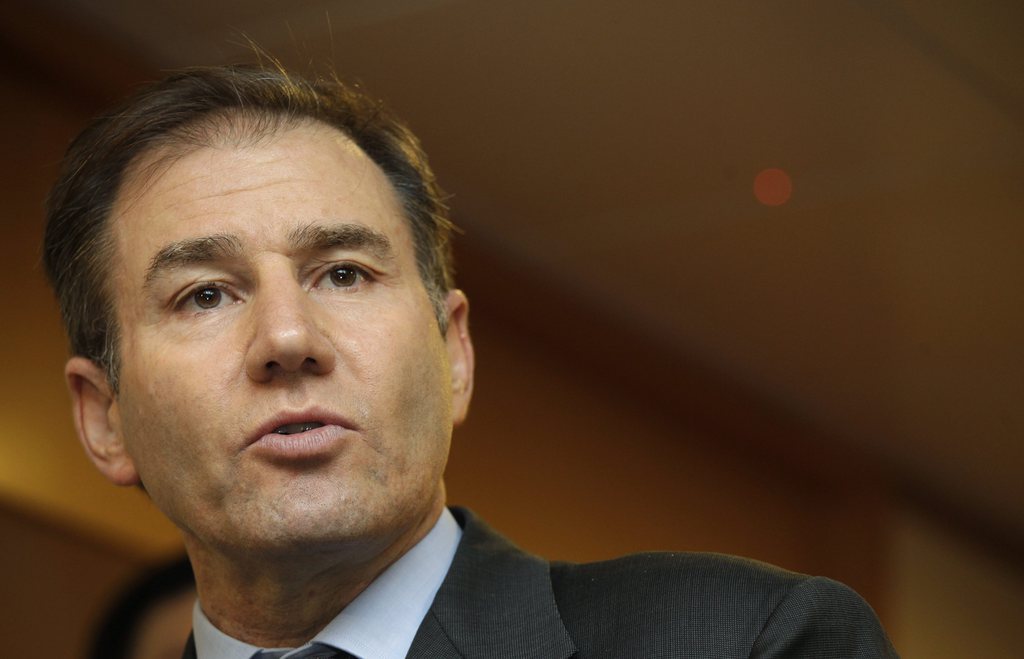Glasenberg’s appetite for deals rumbles on

The Glencore chief’s unique mandate to grow via acquisitions has got the mining sector pondering his next big move.
Ivan Glasenberg, the chief executive of GlencoreExternal link, demonstrated in a 48-hour period this year why the Switzerland-based group occupies a singular place among the world’s biggest mining companies.
With acquisitions taboo for most large miners after a decade-long spending binge, perhaps only the ebullient trader would have followed a $5.85 billion disposal of a Peruvian copper mine with the $1.35 billion purchase of Caracal, a west African oil explorer, a day later.
The flurry of activity showed not only that Mr Glasenberg has retained his eye for an opportunity after the $80 billion purchase of Xstrata last year, but also that he has a unique mandate to expand via acquisition, at a time when peers such as BHP Billiton are reversing years of dealmaking growth and streamlining their businesses.
“The market believes the Glencore management team are a solid allocator of capital,” says Dominic O’Kane, analyst at JPMorgan.

More
Financial Times
External link“What Ivan buys next” has been a favourite mining sector parlour game even before Glencore’s stock market flotation in 2011. Now it is likely to be played with increasing interest. Glencore has digested most of Xstrata as well as Viterra, a Canadian grain trader it bought for C$6.1 billion in 2012, and can take advantage of opportunities while rivals stick to a diet of austerity.
Its shares – currency for large acquisitions – have also started to outperform its mining peers, with Glencore benefiting from its diversity of earnings and lack of exposure to iron ore, this year’s worst performing bulk commodity.
“Optionality”
A buzzword at Glencore’s Swiss headquarters is “optionality”. Glencore denies any goal to grow in a particular commodity, insisting only that any mine, oilfield or agricultural production can be funnelled into its formidable trading and logistics machine.
Mr Glasenberg also stresses that he will give cash back to shareholders, including himself with an 8 per cent stake, if no high-returning growth options emerge. Glencore has already started to return capital, launching a $1 billion buyback last month, while saying it saw plenty of “organic and other growth opportunities to pursue when appropriate”.
One of the miners most frequently mentioned as a likely Glencore target is Anglo American. The venerable mining house underperformed its rivals during the commodities boom and fended off a previous takeover bid from Xstrata in 2009. Chief executive Mark Cutifani is battling to revive its fortunes.
But two of Anglo’s largest businesses are diamonds and platinum, neither of which Glencore trades. In fact, Glencore wants to sell a minority stake in platinum producer Lonmin, inherited from Xstrata. Other Anglo assets such as coal could also cause antitrust issues for Glencore in South Africa. All told perhaps “less than a third” of the business – its iron ore and copper – will interest Glencore, says an adviser.
‘Think bigger’
Some bankers say Glencore can think bigger. Rio Tinto, larger than Glencore by market capitalisation, gains almost all its earnings from iron ore, where its operations are seen as the best in the business. In contrast, Glencore trades but does not mine the steelmaking commodity. The lack of meaningful overlap would make the creation of a “Glen-Tinto” a powerful alternative to BHP, which is spinning off non-core assets.
“If Glencore went for Rio and pulled it off it would be the diversified mining investment of choice,” says Paul Gait, analyst at Bernstein Research. He adds that such a combination will “marry the world’s most important set of mining assets to the most sophisticated commodities trading business . . . it is hard to imagine that there would not be value that would be unlocked through such a combination”.
Rio Tinto shareholders would gain exposure to stronger commodity growth, he says, while managing the combined entity with the same financial gearing that Glencore has today could free up $49bn of cash from the balance sheet to hand to shareholders.
While the idea of a nil-premium merger with Rio has appeal, nothing is imminent, according to bankers. “To persuade Rio shareholders to do a deal with Glencore is a big ask and is only going to happen if they get the fright of their life and the iron ore market turns into a real nightmare,” says one banker.
Sam Walsh, Rio’s chief executive, says the idea of a deal is “really a question for Ivan” not him. “I have said we are not looking at doing M&A. Rio is not eyeing anybody.”
Another potential target is BHP’s so called ‘spinco’, with aluminium, nickel, silver and coal assets. When the demerger is completed next year – with a market value estimated at between $10 billion and $15 billion – it may interest Glencore, say analysts. But Glencore could also look outside mining for its next deal, which is just as likely to be a bolt-on acquisition as a takeover. Few analysts think Caracal will be Glencore’s last deal in oil, while Glencore’s agricultural business still has gaps.
“The type of deals they continue to do will be bolt-on transactions, which tend to be $1bn to $5bn in size,” says JPMorgan’s Mr O’Kane.
People familiar with the company stress that some work remains in integrating Xstrata, while the oil exploration programmes Glencore is running in Chad and Equatorial Guinea will keep its executives busy for some time.
They also say Glencore’s low-cost options to expand mines via so-called ‘brownfield’ expansions alleviate any urgent need for deals: Mr Glasenberg cited opportunities ranging from copper in Congo to thermal coal in Australia alongside interim results in August.
With Glencore insisting investments in industrial assets deliver a return on equity in excess of 20 per cent, Mr Glasenberg stresses that the group will not grow for the sake of growing. “We’re not going to keep the cash in the company [just] because we want to . . . for mergers or acquisitions or to look for bigger projects,” he said recently.
But as Mr Glasenberg weighs his options, he at least knows that he has more freedom to act than any of his industry peers. As one banker puts it: “Glencore is the only miner that has not lost the right to grow.”
Copyright The Financial Times Limited 2014
Glencore deflects impact of iron ore oversupply
Ask Ivan Glasenberg what sets Glencore apart from its peers, and the answer is diversity.
“We have it all,” he declared at the company’s annual meeting in May. “We are the only company that has the mining and marketing and a vast array of assets . . . grain, oil and mining.”
This is in contrast to Glencore’s larger rivals BHP Billiton, Rio Tinto and Vale, which are all highly exposed to iron ore. Rio, for example, generated about 85 per cent of its profits from the steelmaking commodity last year.
The price of iron ore has slumped 36 per cent in 2014 and recently hit a five-year low of $82 a tonne as a tsunami of seaborne supply has hit the market, overwhelming demand. Prices are expected to remain depressed as further production comes online.
Last week, Goldman Sachs said the iron ore industry’s long period of above-trend profitability was at an end.
Glencore’s exposure to iron ore is small and primarily through its trading arm, although it approved a $900 million mine project in Mauritania this year, which is expected to produce 7 million tonnes a year from 2017.
A question for many analysts is whether Glencore looks to take advantage of falling prices to bulk up in iron ore. “It will be interesting over the next couple of months . . . whether they dip their toe into the water. There are some pretty distressed iron ore producers in the market,” says Dominic O’Kane of JPMorgan.

In compliance with the JTI standards
More: SWI swissinfo.ch certified by the Journalism Trust Initiative




You can find an overview of ongoing debates with our journalists here. Please join us!
If you want to start a conversation about a topic raised in this article or want to report factual errors, email us at english@swissinfo.ch.